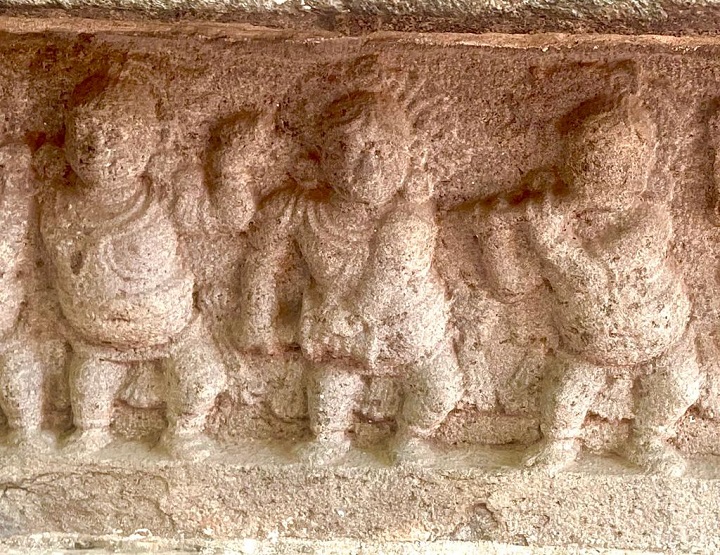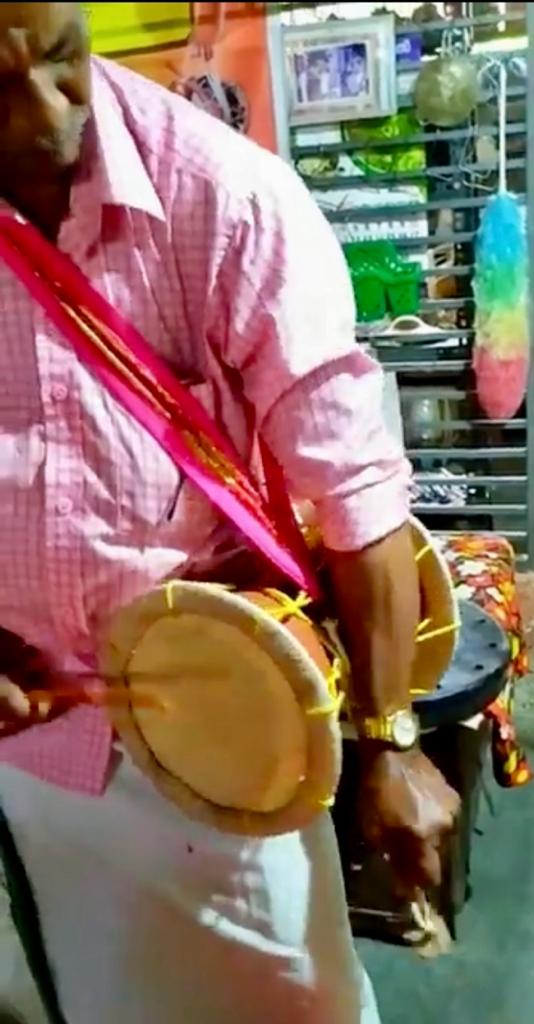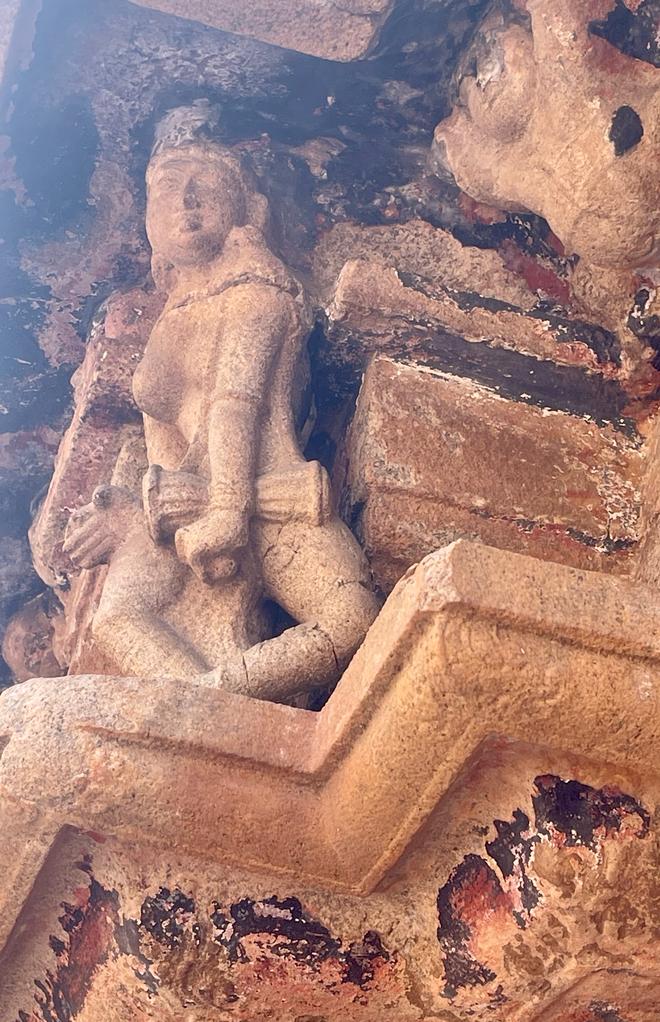 |
 |
 |
http://www.varalaaru.com A Monthly Web Magazine for South Asian History [187 Issues] [1839 Articles] |
 |
 |
 |
http://www.varalaaru.com A Monthly Web Magazine for South Asian History [187 Issues] [1839 Articles] |
|
Issue No. 171

இதழ் 171 [ செப்டம்பர் 2023 ] 
இந்த இதழில்.. In this Issue.. 
|
Author: www.glorioustamils.com; www.attraithingal.com  A short summary of the extensive analysis by Dr. R. Kalaikkovan on Thudi in his article ‘துடி, தமருகம், உடுக்கை‘ is given below, for better comprehension of the most ancient instrument among the five – thudi, damarugam, udukkai, thimilai and idakkai- in discussion. Thudi Thudi and its features, according to Sangam and Post Sangam texts- How did it look? ● the face of thudi or the beaten area was strong and powerful (agananuru 261) ● it possessed a rope which was pressed to bring out different sounds (agananuru 312) ● its face looked like the feet of a young elephant (porunaraatruppadai 125) ● the part that produced sound was called ‘val vaai’ – strong mouth and ‘avvaai’ – beautiful mouth (agam 79) ● the eye on the face of thudi looked like a cut piece of varaal / snake head fish (agam 196, madurai kanchi 320) ● thudi was struck on the strong eye to produce powerful sounds (purananuru 170) ● when not in use, thudi was hung in the front area of houses along with arrows (perumpaanaatruppadai 124) What about its hour glass shape? Silappadhikaram, Thevaram hymns of Appar and Sambandhar and Perungathai – all compare the narrow waist of women to the shape of thudi; ‘Thudi Idai’ continues in Tamil poetry till today. The sound of Thudi ● the high frequency sound of thudi is compared to the throaty neigh of animals (agam 159, 79) ● it was as frightening as the loud hoot of a huge owl (puram 19, 370) ● it sounded like the heavy roar of a waterfall falling from the mountains (pazhamozhi naanuru) ● its sound was similar to the howl of a fierce wild dog (pg. 72, thamizhar tholisai karuvikal) How was the Thudi played? ● one hand held the instrument and the other hand struck it (agam 89) ● it was forcefully played till the hands turned red (puram 170) ● paripadal talks of the lady dancing to the ‘beat of thudi’ and mentions of rotating the gadget while performing ● The drummer also used a stick to strike the thudi (puram 287) When was Thudi played and by whom? ● the field for thudi to be played was during a theft or reclaiming cattle in the Paalai / desert land (agam 372, 379) ● strong men and hunters of Paalai land danced playing the thudi ● it was also a drum of victory; In Agananuru 89, a merchant group was walking behind their donkeys that carried heavy loads. They were escorted by sword holding soldiers for protection. Suddenly, a group of bandits attacked the soldiers and beheaded them. After their successful heist, the swindlers danced to the beats of thudi ● when men returned after a tiresome hunt, they sat to eat their hard earned cooked meat at night. Amidst those who enjoyed their meal, the Pulayan beat the thudi with his strong hands, that turned red due to the hard strike (puram 170) Later Sangam text Paripadal provides glimpses of changes in the usage of Thudi. By now, thudi was also played during festivals. People celebrated the new flow of monsoon waters into the rivers with the strong beat of thudi. A woman is portrayed dancing to the tunes of thudi, swaying her shoulders while her golden anklets filled with pearls jingled (paripadal 21:18-19). In another scene, the wife danced to the thudi beats of her husband while her pearl chains dangled (paripadal 21:60,61). Dr R. Kalaikkovan notes a distinct transformation in the performance of thudi. During early sangam period, men of paalai /desert lands danced to the beat of thudi and in later sangam Paripadal, women of marutham / agricultural landscape, danced to thudi. As an extension of Sangam age, epic Silappadhikaram shows hunters coming out of their habitat in the dark with the deafening sounds of thudi siru parai and kombu (silambu 12:20). Manimegalai talks of thudi struck by watchmen of the town, who walk in the narrow streets (mani 7:69). But in Silambu, Thudi gets connected to Lord Murugan. After his victory over demons, Murugan dances the ‘thudi aadal’, to the tunes of thudi. Thudi continues to be listed as a musical instrument in the hymns of Karaikkal Ammaiyar (4-5th century CE), Appar and Sambandhar (6th century CE); Periya Puranam, Kambaramayanam and Kandha Puranam (12th century CE); and Thirupugazh (14th century CE). However, Appar reveals for the first time the images of Shiva holding thudi in his hand (4:81:07). He plays the thudi as Pichai Thevar (Bhikshadanar) and Kirathaarjunar (the hunter who defeats Arjuna). Chola sculptures are adaptations of these verses. Thudi in today’s kerala and a similar sculpture in Kumbakonam Nageswarar temple –   picture courtesy : Thudi- Kerala Folk Music Instrument, YouTube.com In both the pictures above, the artist’s left hand doesn’t hold the centre of the instrument; instead it seems to be pulling the tassels attached to the central rope downwards. Also, it is intriguing to see the men of Paniyar tribe (who speak the Paniya language that belongs to the Dravidian family) settled in Wayanad, Kerala, make Thudi today – the hour glass shaped traditional drum, with a curved stick (kunil). Interestingly, like the sangam thudi that belonged to the Palai landscape where people worshipped Kotravai as their primary Goddess, here, the Paniya tribes who make Thudi even today worship Kaattu Bhagawathy or Kaali as their chief Goddess. After Thudi here, the next article will focus on Damarugam and Udukkai. Reference books/links- 1. டாக்டர் இரா. கலைக்கோவன், சோழர் கால ஆடற்கலை 2. டாக்டர் இரா. கலைக்கோவன், துடி, தமருகம், உடுக்கை– http://www.varalaaru.com 3. Translation by Vaidehi Herbert, learnsangamtamil.com- Paripadal (21:18-19 and 21:60,61) 4. R.Alavanthaar, தமிழர் தோற்கருவிகள்/ Thamizhar Thorkaruvigal 5. Thudi- Kerala Folk Music Instrument, YouTube.com |

சிறப்பிதழ்கள் Special Issues 

புகைப்படத் தொகுப்பு Photo Gallery 
|
| (C) 2004, varalaaru.com. All articles are copyrighted to respective authors. Unauthorized reproduction of any article, image or audio/video contents published here, without the prior approval of the authors or varalaaru.com are strictly prohibited. | ||